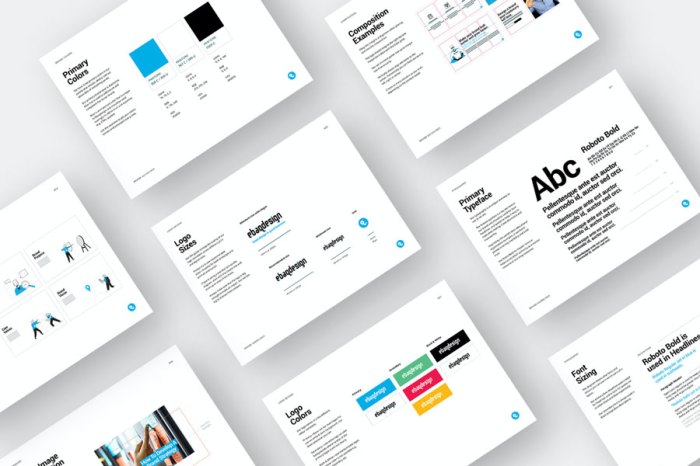Building a Marketing Style Guide sets the foundation for a cohesive brand identity, ensuring consistency and professionalism across all marketing materials. Dive into the world of brand aesthetics and messaging with this comprehensive guide.
Importance of a Marketing Style Guide
Creating a marketing style guide is crucial for maintaining consistency and coherence in all marketing materials.
A style guide serves as a blueprint that ensures the brand identity remains intact across various platforms and campaigns.
Consistency in Brand Identity
- A style guide helps in establishing guidelines for the use of logos, colors, fonts, and tone of voice, ensuring a uniform brand image.
- By maintaining consistency, customers can easily recognize and connect with the brand, fostering trust and loyalty.
- Consistent branding also helps in standing out from competitors and creating a strong brand presence in the market.
Professional Brand Image
- With a style guide, all marketing materials reflect a polished and professional look, enhancing the brand’s credibility.
- It eliminates the risk of inconsistency or errors in communication, presenting a cohesive brand image to the audience.
- A professional brand image creates a positive impression on customers, influencing their perception and decision-making.
Components of a Marketing Style Guide
When creating a marketing style guide, it is essential to include key elements that contribute to maintaining a consistent brand identity. These components help ensure that all marketing materials align with the brand’s values and messaging.
Brand Voice and Tone
Brand voice and tone are crucial components of a marketing style guide as they define how the brand communicates with its audience. It sets the overall personality and attitude of the brand, whether it’s formal, friendly, professional, or casual.
- Example: MailChimp’s brand voice is friendly, approachable, and slightly quirky, which is reflected in their marketing materials and communications.
Logo Usage
Logo usage guidelines in a style guide ensure that the logo is used consistently across all marketing materials. It includes specifications on size, placement, clear space, and how not to distort the logo.
- Example: Apple’s logo guidelines specify that the logo should always be displayed in its original colors and not altered in any way.
Color Palette
Defining a color palette in the style guide helps maintain visual consistency in all brand materials. It includes primary and secondary colors, as well as guidelines on how to use them effectively.
- Example: Coca-Cola’s iconic red color is a central part of their color palette and is consistently used in all their branding materials.
Typography
Typography guidelines specify the fonts to be used in different contexts, such as headings, body text, and call-to-action buttons. It ensures that all text is legible and aligns with the brand’s overall aesthetic.
- Example: Airbnb’s typography guidelines include specific fonts for different platforms and emphasize the importance of readability and consistency.
Designing a Marketing Style Guide

When it comes to designing a marketing style guide, it is essential to focus on creating a visually appealing and user-friendly document that all team members can easily reference. A well-designed style guide can streamline the marketing process and ensure consistency in branding across all channels.
Visual Appeal and User-Friendly Design
One of the best practices for designing a visually appealing style guide is to use a clean and modern layout with consistent branding elements such as colors, fonts, and logos. Including visual examples and illustrations can also help team members better understand how to apply the guidelines in real-world scenarios.
Clear Guidelines for Each Component
It is crucial to create clear and concise guidelines for each component of the style guide, including logo usage, color palettes, typography, tone of voice, and more. Providing examples and explanations for each guideline can help team members adhere to the branding standards effectively.
Accessibility and Ease of Reference
To ensure the style guide is accessible and easy to reference for all team members, consider creating a digital version that can be easily shared and updated. Organize the guide in a logical manner with a table of contents, searchable s, and interactive elements for quick navigation.
Implementing and Maintaining a Marketing Style Guide

Implementing and maintaining a marketing style guide is crucial for ensuring consistency and coherence across all marketing channels. It helps in establishing a strong brand identity and resonating with the target audience effectively.
Strategies for Implementation
- Conduct comprehensive training sessions to educate team members about the style guide and its importance.
- Integrate the style guide into project management tools to streamline the implementation process.
- Regularly review and provide feedback on how the style guide is being applied in various marketing materials.
Importance of Regular Updates
Regular updates and revisions are essential to keep the style guide current and aligned with the evolving market trends and consumer preferences. It ensures that the brand remains relevant and maintains a competitive edge in the industry.
Tips for Adherence
- Hold regular check-ins and audits to evaluate if team members are following the guidelines Artikeld in the style guide.
- Create a centralized repository for the style guide where team members can easily access the latest version.
- Provide ongoing training and resources to help team members understand and implement the style guide effectively.
Benefits of Consistent Branding: Building A Marketing Style Guide
Consistent branding is crucial for establishing a strong brand identity and building customer trust. When a brand maintains a consistent look, feel, and messaging across all touchpoints, it becomes easily recognizable to consumers. This enhances brand recognition and creates a sense of reliability and credibility.
Enhanced Brand Recognition and Customer Trust
Consistent branding helps consumers quickly identify a brand amidst a sea of competitors. For example, when you see the iconic swoosh logo, you immediately think of Nike. This instant recognition builds trust and loyalty among customers, as they know what to expect from the brand.
Impact on Customer Loyalty and Engagement, Building a Marketing Style Guide
A cohesive brand identity fosters customer loyalty by creating a strong emotional connection with the brand. When customers resonate with a brand’s values and messaging, they are more likely to remain loyal and engage with the brand on a deeper level. For instance, Apple’s consistent branding has cultivated a loyal customer base that eagerly anticipates new product launches.
Successful Examples of Consistent Branding
Companies like Coca-Cola, McDonald’s, and Starbucks have successfully leveraged consistent branding practices to become global household names. Their logos, color schemes, and messaging remain consistent across all platforms, creating a unified brand image that resonates with consumers worldwide.





